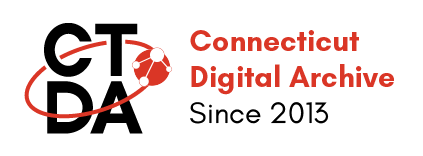CTDA’s Statement on Sensitive Content
Note: This statement was developed from DPLA’s Statement on Potentially Harmful Content and is used and modified by permission of the DPLA. It has been altered to reflect unique aspects of the CTDA and its relationship with its members.
The Connecticut Digital Archive (CTDA) is a portal to millions of freely available items from hundreds of libraries, archives, museums, cultural heritage organizations, community archives and individuals in Connecticut.
CTDA content may contain sensitive language or subject matter. Our members collect materials from history, as well as artifacts from many cultures and time periods, to preserve and make available the historical record. As a result, some of the materials presented here may reflect outdated, biased, offensive, and possibly violent views and opinions. In addition, some cultural heritage institutions collect and preserve materials relating to violent or graphic events which are preserved for their historical significance.
Frequently Asked Questions
Where does this content come from?
CTDA contains and makes freely available materials from more than 100 libraries, archives, museums, cultural heritage organizations, community archives and individuals in Connecticut.
Each member deposits materials in the CTDA according to their specific policies and objectives. CTDA preserves this content but does not determine what content members may deposit or how it is presented and described. Members continue to own and are responsible for describing their own content according to their own policies.
What sensitive content may be found in CTDA?
Some items may:
- reflect white supremacist and American imperialist ideologies, which include racist, sexist, misogynistic/misogynoir, and xenophobic opinions and attitudes.
- be discriminatory towards or exclude diverse views on sexuality, gender, ableism, religion, and more.
- include graphic content of historical events such as violent death, medical procedures, crime, post mortem photography, wars/terrorist acts, natural disasters and more.
Why does CTDA make sensitive content available?
CTDA’s members collect, preserve, and present these materials as part of the historical record, which does include depictions and records of people experiencing trauma and harm. Members working in conjunction with CTDA seek to balance the preservation of this history with sensitivity to how these materials are presented to and perceived by users.
How is this material described, and why are some of the terms used in the descriptions harmful?
- Members choose what language to use when describing materials. Some of these descriptions were written many years ago, using language that was accepted at the time.
- Members often re-use language provided by creators or former owners of the material. This can provide important context but can also reflect biases and prejudices.
- Members often use a standardized set of terms, such as the Library of Congress Subject Headings, to describe materials. Some of these terms are outdated, offensive, or insensitive.
- Communities with less access to and privilege within libraries and archives have had less control over how they are represented and described.
CTDA is committed to working with its partners to assess and update descriptions that are harmful while preserving the historical context of those descriptions.
How are members and the CTDA working to address this problem and help users better understand such content?
The CTDA works with its members and Connecticut Humanities on a number of initiatives designed to address this problem.
Examples include:
- Supporting CT Humanities Working Groups on Reparative Cataloging
- Informing users about the presence and origin of sensitive content.
- Making available more diverse standardized sets of descriptive terms beyond the typical.
- Researching the problem, listening to users, experimenting with solutions, and sharing our findings with each other.
- Working directly with misrepresented and underrepresented communities to improve the ways they are represented.
- Making an institutional commitment to DEIA (diversity, equity, inclusion, and accessibility).
How can I report content I consider harmful?
You can help us understand this issue and find solutions by reporting harmful content to the CTDA through out contact pages
CTDA will forward your report to the member(s) that are responsible for the content. It is up to each individual institution to determine whether or not they will change or remove the content. Institutions weigh potential harm against considerations such as accurate preservation of the historical record, professional best practices, and allocation of scarce resources.
CTDA will use all reports of harmful content to better understand the issue and educate other members.

